Manzai duo "Panku Bubu" won the M1 Grandprix this year, in a unanimous decision over Waraimeshi and Non Style. I was rooting for Waraimeshi, but there you go. Panku Bubu won 10 million yen (about 100K USD). Better luck next year, Waraimeshi.
Sunday, December 20, 2009
Sunday, November 15, 2009
39 Goroawase! - Japanese Word Play
One fun and unique feature of Japanese language is the ease with which you can create easy-to-remember phrases from numbers. I assembled a little database of these "goroawase" mnemonic helpers, for students of Japanese to see. Check out this page, and contribute if you can. (Can you guess what 39 is, before you look at the database?)
Monday, September 21, 2009
Yanagihara Kanako Senryu Haiku
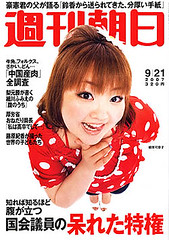 Kanako Yanagihara is so popular these days, that shop assistants are starting to impersonate her right back! I heard a shop full of assistants doing their best Kanako schtick, so a senryu haiku came to mind:
Kanako Yanagihara is so popular these days, that shop assistants are starting to impersonate her right back! I heard a shop full of assistants doing their best Kanako schtick, so a senryu haiku came to mind:
君は今
kimi wa ima
加奈子さんより
kanako san yori
柳原
yanagihara
What I mean is, "you're more Yanagihara than Yanagihara Kanako".
Thursday, August 20, 2009
Satirical Shibamata Senryuu
The elections are again upon us here in Japan, and the satirists are hard at work writing Senryuu (川柳) poems about the subject. Senryuu are like Haiku in that they have the well-known 5-7-5 sound structure, but they differ in that they are not so much about mother nature as about human nature.
You can see some Senryuu from my post about the annual Salary-man Senryuu competition held by Dai-ichi Life Insurance, about the trials of the typical salaried worker (meaning, most of Japan's population). This time, the buzz is about the upcoming House of Representatives election, and there are several humorous Senyruu decorating the Shibamata Taishakuten (柴又帝釈天) Temple in Katsushika Ward, Tokyo. These will remain on display until around early September.
Let's take a look at some of the Shibamata Senryuu, with my translations:
手袋の
Tebukuro no
白さに隠す
Shirosa ni kakusu
腹の中
Hara no naka
White gloves
Seem to be hiding
Your real intentions [1]
大風呂敷
Oo furoshiki
にまどわされて
ni madowasarete
票を入れ
hyo wo ire
Stunned by your
Impressive large furoshiki
I vote for you [2]
バラの花
Bara no hana
咲くと公約
Saku to kouyaku
枯れてくる
Karetekuru
As the roses bloom
Your campaign promises
Wilt away [3]
字が読めず
Ji ga yomezu
末は首相と
Otto wa souri to
おだてられ
Odaterare
Can't read the kanji!
With the Prime Minister
My husband freaks [4]
マンガ好き
Manga zuki
末は首相と
Otto wa souri to
息子言う
Musuko iu
The manga freak
My husband, gripes about
The PM and our son [5]
[1] The phrase "hara no naka" is a common Japanese use of the hara or "gut", or "inside your gut", your dirty intentions.
[2] Oo furoshiki means "big talk".
[3] They put out roses when counting votes. This implies as soon as the roses are in bloom, or the votes are being counted, politicians' promises die away.
[4] PM Aso is infamous for making mistakes in reading kanji, which are not really so hard to read either (even I could read some of them.) The PM's and the husband's "freaking" here is for opposite reasons and the original "odateru" is more like "to become agitated".
[5] PM Aso is a big manga-lover. The writer's husband loves manga, but does not hesitate to criticize his son or the PM.
There is considerable humor in Japanese life, so it would be shortsighted to think Japan does not enjoy it. Enjoy!
Wednesday, August 19, 2009
Japan Rail is More Gaijin
I noticed something interesting. The JR East Japan announcements about the next station are done in a female voice, and she used to say the station names with proper Japanese pronunciation.
The next station is, SHIMbashi.
They've re-recorded some of the announcements though, seemingly with the same "voice talent", and there's a subtle difference. She now says the station names with a "gaijin" accent.
The next station is, shimBOSSshi.
What's up with that? Were people not getting the names right? Did some consultant trying to justify their existence tell JR that they needed to say it more like "gaijin" say it? I'd say that would be gaijin of the American English speaking variety, though. How curious.
I noticed it the other day, and today it was the original way, so I am not sure what the pattern is yet. Maybe different lines have different patterns. Japanese are pretty obsessed with regional language differences, though. There's a comedy duo called "Yuji Koji" who hysterically make fun of the difference between the regions and Tokyo. Even my car Navi has a setting to make it talk with an Osaka accent.
300m saki, hidari yade.
Monday, July 20, 2009
Japan Marine Day "Umi no Hi"'s Roots
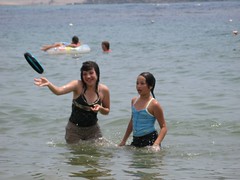 The third Monday in July is "Marine Day" here in Japan, called "Umi no Hi" (海の日) in Japanese. It was established in 1996, a few years into my life in Japan. It's common knowledge that the day marks the return of the Emperor Meiji from a boat trip. More specifically, it's the day of his return to Yokohama port in Meiji 9 (1876), from a royal light-house inspection tour to the northernmost prefectures, on a Scottish-built schooner called the "Meiji Maru".
The third Monday in July is "Marine Day" here in Japan, called "Umi no Hi" (海の日) in Japanese. It was established in 1996, a few years into my life in Japan. It's common knowledge that the day marks the return of the Emperor Meiji from a boat trip. More specifically, it's the day of his return to Yokohama port in Meiji 9 (1876), from a royal light-house inspection tour to the northernmost prefectures, on a Scottish-built schooner called the "Meiji Maru".
That factoid leaves me wondering why that trip was so important, and why the Emperor Meiji's return from the northern prefectures needed to be marked. Was that like visiting ganglands, or something? Or was it just an example of the vast modern bureaucracy needing a "real reason" to call it official and torment hordes of schoolkids with memorizing? In all seriousness, to the Japanese of the time, I imagine that having your image of a God be on a boat, sailing around the coast in rough northern waters would be enough to make people nervous wrecks!
Umi no Hi is a secular, national holiday, so there are no Shinto festivals associated with the day. The government party line is that Umi no Hi is to "express gratitude for the bounty of the oceans and hope for the prosperity of Japan's marine industry". I guess that makes sense, given the importance of the marine industries to Japan's economy.
That said, most people just use it to take advantage of a three-day weekend and have a short trip to the beach! We, on the other hand, are using it this year to go see Harry Potter since the weather's looking pretty bad today!
Monday, July 13, 2009
Kenkoshindan Health Check
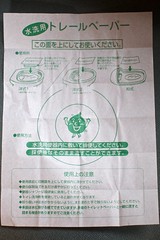 My wife and I did our yearly "kenkoshindan" health check via our insurance provider the other day. If you are on the national insurance plan or one of the big alternative providers, you're supposed to get this kenkoshindan once a year. My wife and my secretary at work badgered me into submission, so I finally took the plunge and got the big one-day "ningen dock" (人間ドック, and kind of like "human dry-dock" in its meaning).
My wife and I did our yearly "kenkoshindan" health check via our insurance provider the other day. If you are on the national insurance plan or one of the big alternative providers, you're supposed to get this kenkoshindan once a year. My wife and my secretary at work badgered me into submission, so I finally took the plunge and got the big one-day "ningen dock" (人間ドック, and kind of like "human dry-dock" in its meaning).
So What's this Ningen Dock?
Glad you asked. Being over 40 (ok, ok, I'm 43), this time I signed up for the standard ningen dock set, instead of the wimpy blood and urine test only. Once you get to the center, after NOT eating breakfast, they give you a nice top/bottom to change into, so you to to a locker room, strip to your skivvies and put that on. It's not a paper gown like you might see at an ER, but a proper outfit much like pajamas. The arms were short and the bottoms were held up by a drawstring. They include socks too, in case you wear the ones with the holes (like me!) on the big day.
I wish I could have taken a photo of the waiting room, because it was a trip to see all the men in their green-ish gowns, the ladies in their pinkish gowns, nurses in light blue and docs in white. All organized and color-coded; very efficient and impressive. There were many many magazines in the waiting room, but all were in Japanese, so it might make sense to bring reading materials if you want to read while waiting.
There was not much waiting time, to be frank, and the whole thing was over in 3 hours. Here's what was included in the tests:
- Urine and Stool - they take the urine on the day, 25 mL, but you get to do the stool sample beforehand, refrigerate it, and bring it along! There's a little sample kit, and the pictured "toreeru" paper poop catcher sheet, onto which you do your business, and then use the included swab set to snag a sample. In the picture, you can see the humorous target con "Mr. Happy Poop" character illustration. Kind of breaks the ice a bit, makes you laugh about having to do the sample, so it works in a perverse way.
- Chest X-ray - just a simple X-ray from the front and side.
- Blood Test - simple and quick, they took three vials of blood.
- Blood Pressure - just a standard BP measurement.
- Height, Weight, Bodyfat - after they measure your waist, you stand barefoot on an automated reader, which takes your measurements and spits out a little printout with the vital statistics. Of course, males in Japan are "obese" when they have a waist over 85 cm, so, er, I guess I better keep up the exercising!
- Lung Capacity - you "inhale until it hurts" then "exhale with all your might", and the machine makes a neat little graph. No wonder everyone says I have such a loud mouth!
- Vision - this was a glasses-on, look at an eye chart exam, followed by a retinal scan and a glaucoma test.
- Hearing - you go into a sound booth, put giant grape-fruit-sized headphones on, and press a button when you hear something, releasing when you don't. Goes on for quite a while in both ears.
- EKG - they hook your limbs and several points on your chest up to a heart monitor, but the probes are not designed for hairy foreigners. The suction cups fall off, which causes laughter, which causes more falling off and struggle. The test itself is only 10 seconds or so of measurement.
- Ultrasound - this is an alternatively ticklish and somewhat uncomfortable test where they are taking pictures of your internal organs. They grease you up, and tell you to inhale so that your navel sticks out, and press the ultrasound wand into your torso in various places. It's not really painful, but it's not a sensation you get every day where people are pressing a relatively hard object into your liver, kidneys or ribs. It took 30 minutes and I was a little bruised. It must not be easy to do, because they switched operators in the middle, which I think is for training.
- Barium Drink - this is so they can see the surfaces of your stomach and esophagus, so they have you drink a carbonate powder which is kind of like ingesting a Coke in 3 seconds because when it hits your stomach it swells it up. You're supposed to resist the urge to burp! Then you swallow the barium solution, which is a thick white substance, like Pepto Bismol but without the nice taste. Then, following a myriad of rules (no burping, no turning to the left), you hold onto a machine you're lying on, which tilts this way and that, and you turn yourself according to the directions. Very fast, very uncomfortable, and a lot like being on a roller-coaster. All the while, you're suppressing that burp, so when they say "ok, you can burp now" you're ready! After, they give you a laxative, saying that the barium has a tendency to plug you up. You're supposed to take one now, then take another "if the white barium stool" does not come.
To close, you go downstairs where they give you a warm drink and a cookie, you have an interview to discuss your results with a doc, and then after you return your pastel pajamas, you're released into the wild to abuse yourself with food, drink and other vices for another year. :-)
Thursday, June 25, 2009
Japan and Its People are Unique
At least that is what they tell me! I like Japan and have had some interesting, enjoyable and indeed unique experiences here, otherwise I would not have stayed in this country since 1987. But over the years, I've had an earful of people telling me directly or indirectly how unique Japan and its people are, and I've had to burst more than one person's bubble. Sometimes incorrectly.
A couple examples of the oft-heard "unique" characteristics of Japan and its people, from my first-hand experience:
- Only Japan has four seasons. So my teachers lied to me about the nature of Spring, Summer, Winter and Fall? I'm shocked!
- Japanese intestines are unique, so that is why Japanese cannot digest foreign rice and cannot import US beef. Quick, revise the anatomy textbooks.
- Foreigners cannot understand the unique Japanese concepts of dignity and morality. Just ask Konishiki who was practically put on trial for not being dignified enough to perform his sumo-ly duties at the highest level, but while you do that, ignore the Japanese abusive Sumo stablemasters.
- Japanese pregnancies take 10 months (!). It's possible that all that extra moral development occurs in utero, but I kind of bet it's got something to do with lunar months or the ancient Japanese counting 0 as 1.
- Japanese Kafunsho (hayfever) does not exist in other countries. Put away that Allegra, you buncha fakers.
- The snow in Japan is special, and unique, and that's why we cannot import foreign ski equipment because it just doesn't work here. Ah huh. A patent on crystallized water?
Of those, I dismissed the Japanese intestines-are-unique thing as being more politician wind-blow, but there is anecdotal evidence I've read in favor of it being true. I have to admit that that's physiologically possible for races (i.e. caucasian vs mongoloid) to be physically different, but the problem arises when eager-beaver politicians try to further some agenda by linking a longer Japanese intestine to Japanese "not being able to digest" certain foods. Same goes for thinking that "Japanese snow is unique", and therefore foreign skis won't work on it. Rubbish.
What I believe is unique are the aspects of the Japanese language that allow a detailed and evocative rendering of the weather, or seasons, a la Basho or a writer like Kawabata. By the same token there are things that Japanese language does not handle well, like anatomical descriptions. That's part of the reason the doctors use German and English and not Japanese, to describe ailments. So it's not necessarily that the Japanese language is "better", but that there are some well-developed aspects and some not-so-well developed aspects.
Rather than have a strange fixation on these comfortable yet largely inaccurate trivialities steeped in the language and (ill)logic of nihonjinron thinking, I would hope that the Japanese would focus on some of the genuinely amazing and far-reaching achievements of their countrymen, like Takamine's isolation of Adrenalin, the various management techniques of Toyota, or their wonderful cultural treasures (and I don't mean manga and maid cafes). I would hope that the government would teach the Japanese children, my children included, the true beauty of Japan, rather than resorting to weak arguments.
I'll leave you with something I saw today that triggered this aside, and thinking about my time here. Eric Hilton wrote in to the the Japan Times that he supplied a student with the (in my opinion very adroit) translation of a popular Japanese proverb "saru mo ki kara ochiru" (even monkeys fall from trees) as "even Homer nods", and he said that the student was amazed that proverbs even exist in English. Now that takes the cake, but at least one can say that the child is just an ignorant student.
That's more than we can say for the people who put such ideas into his head.
Tuesday, June 23, 2009
"Gyaru-go" Girl Japanese
Mezamashi TV had a segment on the lastest gyaru language. If you're not familiar, gyaru are the sort of schoolgirls who hang out in Shibuya or Harajuku, dress in the latest fashion and speak in a sort of code. Here's the three I remember:
- ムカTK mukaTK - mukatsuku, to be pissed off. The original's just as easy, ladies.
- モレる moreru - um, to be dressed up, with your hair in a bun with cute accessories. Comes from "moritsukeru" to decorate.
- シカメ shikame - from shikato and meeru, ignore mail. To have blown off answering someone's text message. I hear that a large percentage of schoolkids get really stressed about "shikame", in all seriousness.
At any rate, remembering these is one thing, but using them is another, so remember this: if an "oyaji" (middle-aged guy) like me uses gyaru-go, he's ostracized by his daughters and subjected to the "uzai" label for all time. :-)
Monday, June 22, 2009
"One Coin" Services All the Rage in Japan
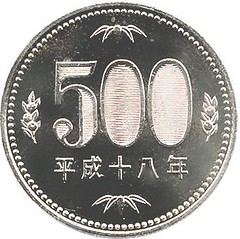 Japan morning TV reported that "One Coin" (ワンコイン) services are all the rage these days in Japan, due to the down economy. What this phrase means is that you can buy a good or service with a single 500 yen coin, or about USD 5.00.
Japan morning TV reported that "One Coin" (ワンコイン) services are all the rage these days in Japan, due to the down economy. What this phrase means is that you can buy a good or service with a single 500 yen coin, or about USD 5.00.
Indeed, you can see them here and there:
- "Makudonarudo" McDonald's has a 500 yen value set.
- "One Coin" lunches at salary-man lunch joints.
- Short foot massages for 500 yen.
- "Test Esthe" at Miss Paris Esthetic Salon for "one coin".
- Yoshinoya and Matsuya meat bowls for 500 yen.
Next time you're out and about in Tokyo, keep an eye out for "one coin" ワンコイン services.
Sunday, June 21, 2009
Tokyo Metro "Do It At Home" Manners Posters
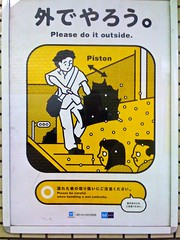 Artist Bunpei Yorifuji (寄藤文平) is creating a series of manner posters for the Tokyo metro, around the theme of "Do It At Home". Yorifuji was born in Nagano Prefecture, Japan, in 1973, and founded Bunpei Ginza in 2000 to specialize in mainly Art Direction, Illustration and Book Design.
Artist Bunpei Yorifuji (寄藤文平) is creating a series of manner posters for the Tokyo metro, around the theme of "Do It At Home". Yorifuji was born in Nagano Prefecture, Japan, in 1973, and founded Bunpei Ginza in 2000 to specialize in mainly Art Direction, Illustration and Book Design.
Yorifuji's manners posters address the most common complaints heard by the Metro, such as people who apply makeup, party, sit on the floor, take up too much room, jump through the closing doors at the last minute, wear Everest-assault-sized backbacks and so on.
I have to chuckle at the rather awkward and sometimes double-entendre Engrish, but that's what gives them charm, I suppose. I even found a spoof poster.
Clicking through on the official website, and viewing all of the posters, I can see a trend: the middle-aged and distressed-looking couple present in some form in the posters is supposed to represent Mr. and Mrs. Everyman, and according to an interview I read, Yorifuji says their glasses make their emotions harder to read, letting the viewer assume they're upset by the bad manners in the poster.
What irks me about this set of posters however, is that there are plenty of middle-aged people with awful public manners but in this series it's almost always the children who are portrayed as the offenders. Yorifuji san, what about the drunken salarymen, the obatarians violently charging for seats or the malodorous gyoza-chompers?!
Click the thumbs below for the spoof poster and the official website.
Ray-Out's iPhone "Jacket" Case Review, DIY Fix for D-Ring Problem
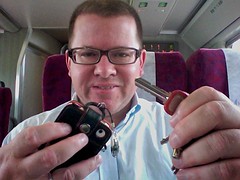 I purchased Ray-Out's reasonably-priced leather "Jacket" case, model RT-P1LC4/B, perhaps three months ago from Yodobashi Camera. I was looking for a case that had a "strap loop" so that I could hang the iPhone around my neck for going to meetings or lunch, as I don't trust myself to put the iPhone in my pocket and have it survive even one day! The Ray-Out leather jacket was one option, and the other was so bling-bling it wasn't even a choice for me.
I purchased Ray-Out's reasonably-priced leather "Jacket" case, model RT-P1LC4/B, perhaps three months ago from Yodobashi Camera. I was looking for a case that had a "strap loop" so that I could hang the iPhone around my neck for going to meetings or lunch, as I don't trust myself to put the iPhone in my pocket and have it survive even one day! The Ray-Out leather jacket was one option, and the other was so bling-bling it wasn't even a choice for me.
DIY Fix for the RT-P1LC4/B Loop Problem
Unfortunately, the D-ring that came attached to the case by a leather loop came off, sending the iPhone plummeting to the ground. At least the case's leather hit the ground instead of the actual phone, so my iPhone still works. Ray-Out should re-design that little loop for the D-Ring, because after even a couple month's of use, it became weak and ripped.
I thought of using a loop of cable in a rubber tube (Tokyu Hands has the parts) but in the end I just took one of those key identifier rings, which are made of strong rubber, and fed the snap-tab through it to make a loop to which my neck strap could be attached.
Ray-Out RT-P1LC4/B Pros and Cons
The pros of the Ray-Out RT-P1LC4/B case are, it looks relatively good (though I'd like an option other than orange for the accents), it's sturdy except for the leather D-ring holder, and it's got a card holder which is perfect for your Suica train pass or whatnot.
I'm afraid the cons stand out, though:
- The D-ring for attaching wrist- or neck-straps to is held in by a very weak loop of leather. Sure enough, it rotted and came off in only three months since I started using the case. Hence the DIY fix.
- The strap D-ring is on the "wrong" side of the case. When you attach a neck strap to this D-ring and try to use the phone, things get tangled. It would be much better if the D-ring were on the speaker-side of the iPhone, so you don't have to struggle with straps getting in the way when you're trying to use the phone while it's tethered to you.
- The edges of the case sometimes get in the way of typing, especially in apps like Photogene, where the function icons are to the hard left of the screen. It's also kind of hard to move the icons around from page to page with this design.
Here are a few photos of the case, just in case.
Saturday, June 20, 2009
Drop - Enough to Scare the Crap Out of You
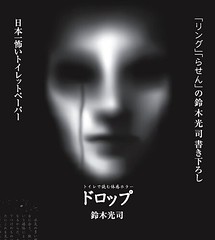 "Drop" is a horror story novella written by Koji Suzuki, the writer of best-selling horror stories such as "Ring" and "Rasen" (Spiral). Suzuki san was born in 1957 in Shizuoka Prefecture, Japan, and his books have sold more than 8 million copies.
"Drop" is a horror story novella written by Koji Suzuki, the writer of best-selling horror stories such as "Ring" and "Rasen" (Spiral). Suzuki san was born in 1957 in Shizuoka Prefecture, Japan, and his books have sold more than 8 million copies.
Thing is, Drop's not your run-of-the-mill novella; it's printed on toilet paper. The Japanese summer is a time for telling horror stories around a campfire or watching the annual scary TV shows, and many Japanese horror stories are set in toilets, so it's quite fitting that there be a horror story written right on your toilet paper, actually.
Drop is produced by Hayashi Paper, and can be purchased in Japan via Banbix. A case of 24 rolls of Drop toilet paper costs JPY 2400 before tax. Banbix says they don't accept orders from or ship outside of Japan, so you're SOL even if you can read it.
Drop is enough to scare the crap out of you, literally, and I'd want my own roll to be able to finish the thing uninterrupted. Either way, stay clear of the toilets in Japan, and have a scary summer. :-)
Saturday, June 6, 2009
Street Jazz from Kano, Saito, Kawamoto
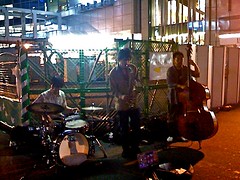 I've seen this good, energetic "Street Jazz" trio at JR Shinjuku before, but today I waited for a good moment and got some materials from them. The musicians were George Kano on drums, Chikara Saito on Alto Sax, and (probably) Sousuke Kawamoto on upright bass. The flyers I got were pretty clear on who the sax and drum players were, but I'm not so sure about the bass player. Either way, they are all really good musicians.
I've seen this good, energetic "Street Jazz" trio at JR Shinjuku before, but today I waited for a good moment and got some materials from them. The musicians were George Kano on drums, Chikara Saito on Alto Sax, and (probably) Sousuke Kawamoto on upright bass. The flyers I got were pretty clear on who the sax and drum players were, but I'm not so sure about the bass player. Either way, they are all really good musicians.
As a drummer myself, I was really impressed with George. He's got a lightweight kit that he can probably pack in one or two relatively small bags, with roto-toms, the sound of which of course reminds me of the Bridgemen and of Bill Bruford.
iPhone Recordings
They were jamming along, so I whipped out the iPhone and snagged a couple of recordings which I hope you enjoy. The top one's Dizzy Gillespie's A Night in Tunisia and I'm afraid I cannot remember the second one. I've heard it before, and at first it sounded a bit like Hancock's Watermelon Man but I think it's not. (If you know, let me know!)
Websites
Their flyers had a whole bunch of websites on them, which are all in Japanese. From looking at the sites, it appears these cats play in various combinations. At any rate, here's a few useful links for them in Japanese:
- Mixi Community "STREET Jazz" [1]
- Drummer Kano George's Personal Site and iDep Site
- Alto Sax Player Chikara Saito's ElectricRicky Site
- Bassist Sousuke Kawamoto's Personal Site and Alabama Crossover Site
Recommendations
Guys if you'll indulge me for a moment, it takes skill to play as fast and furious as you do, but it also takes huge skill to play slow. Dig "When We Were Free" from Pat Metheny's Day Trip. The musicians can and do stretch in this tune but the basic tempo is really easy-going.
Also, please ditch the long, complicated URLs on your flyers. Sorry, but this sort of URL is absurd to make someone enter:
http://ip.tosp.co.jp/i.asp?i=kanogeorge
... because it's too complex. You want to let your potential listeners enter something really simple. Use an URL shortener like TinyURL or Bitly to create permanent, short URLs. I created two from George's site:
Please consider using those, and keep up the great playing!
[1] Mixi is a Japanese SNS.
Thursday, June 4, 2009
Family Reunion Sad
 Every year, we have a family reunion during the New Year holiday "oshogatsu". The photo in this post is of the 2009 edition.
Every year, we have a family reunion during the New Year holiday "oshogatsu". The photo in this post is of the 2009 edition.
This is A Big Deal for the family here, and they do it without fail. Missing it is also A Big Deal, so I think we've missed it once in the past 15 years. I gather it's an Asian thing to have these big family gatherings, but I always feel like the odd man out, when the conversation turns to whatever it is that 60-ish-year-old Japanese folks like to talk about.
Though I enjoy the company and drink and food, great food, these also make me long for home, to see my Mom and Dad, Sister and Brother and everyone's families and friends. Ah, if only Star Trek teleportation was possible! Oshogatsu omedeto!
Tuesday, June 2, 2009
Finally. OTC Drugs at 7-11
 The Pharmaceutical Affairs Law "PAL" was revised to allow convenience stores like 7-11, Lawson, Family Mart or others to sell most over-the-counter drugs, so long as they have a clerk who has registered and qualified with the local government. The fact that they no longer need a pharmacist is a big cost-saving difference from before, that also allows a big new income stream for the conbinis.
The Pharmaceutical Affairs Law "PAL" was revised to allow convenience stores like 7-11, Lawson, Family Mart or others to sell most over-the-counter drugs, so long as they have a clerk who has registered and qualified with the local government. The fact that they no longer need a pharmacist is a big cost-saving difference from before, that also allows a big new income stream for the conbinis.
Cloudy for Some
I'm not sure why, but the same revision to the PAL took the step of banning Internet sales of OTC drugs. The Ministry of Health Labor and Welfare cites the reason that the drugs should be sold with qualified registered clerks in attendance as the reason.
Sounds like skittishness or hyper-conservatism to me, or that MHLW had evidence of some wrongdoing by the Internet vendors and decided to take action this way. The surface explanation is probably not the real reason.
How to Tell
While I can't divine the internal workings of Japanese bureaucracy, on a practical note, if the convenience store has medicine available, you'll probably see the characters くすり or 薬 in the window.
I've been waiting for this for years. Having been here since 1987, I remember going back to the US and noticing you could always buy things like Tylenol and Pepto Bismol at the 7-11, but the day has finally come in Japan.
Saturday, May 23, 2009
Salaryman Senryu "Sarasen" Winners
Dai-ichi Life Insurance has announced their latest Sarariiman Senryuu (Salaried Worker Senryuu, サラリーマン川柳) competition winners. It's the 22nd year for the competition, and people vote on the best humorous senryu that come from the daily life of salaried workers and the news. Senryu are like Haiku but are less about nature than about human life, and you may recall that haiku are the poems with a cadence of 5, 7 then 5 syllables. Let's check some of the sara-sen winners out with my translations:
僕の嫁
boku no yome
国産なのに
kokusan nano ni
毒がある
doku ga aru
My Wife
Made in Japan
Yet Poisonous [1]
子供らに
Kodomora ni
また教えてる
Mata oshieteru
総理の名
Souri no na
Once again
I teach the kids
The PM's name [2]
コスト下げ
kosuto sage
やる気も一緒に
yaruki mo issho ni
下げられる
sagerareru
Cost-cutting measures
My motivation too
is cut
職安で
Shokuan de
知った顔見た
Shitta kao mita
あ、上司
a, joushi
At the job-center
I know that face
Oops, my boss!
久しぶり
Hisashiburi!
ハローワークで
Haroo Waaku de
同窓会
Dousoukai
Hey! Good to see you!
It's a reunion
At Hello Work [3]
やせたのは
Yasetano wa
一緒に歩いた
Issho ni aruita
犬の方
Inu no hou
All that walking
The one who lost weight
Was the dog
Who says the Japanese don't have a sense of humor!?
[1] The poison quip of course refers to the series of tainted food scandals, and plays on the idea that domestic Japanese food is supposed to be "safer".
[2] This refers to Japan's Prime Minister revolving door.
[3] Hello Work is a job center located in every town in Japan, where the unemployed can go to submit their resume and apply for work.
Sunday, May 17, 2009
Saboten no Hana Lyrics - Kazuo Zaitsu
Kazuo Zaitsu (kanji: 財津和夫) of the Japanese band Tulip, is the singer of a favorite song of mine, "Saboten no Hana" or The Cactus Flower, which is a song about hope despite love lost. It was the theme song of an enormously popular 1993 drama called "Hitotsu Yane no Shita" or Under One Roof. Zaitsu san has a unique and pleasant voice that I like, and this song always brings a tear to my eye. The song features a simple piano solo in the bass register, which to me is the man's sad voice mixed with hope.
I thought I'd translate the lyrics so others could understand it too. You can see Zaitsu san sing it and see some stills from the drama on YouTube.
Saboten no Hana サボテンの花
ほんの小さな出来事に 愛は傷ついて
Hon no, chiisana, dekigoto ni, ai wa, kizu tsuite
君は部屋をとびだした 真冬の空の下に
Kimi wa, heya wo, tobi dashita, mafuyu no sora no shita ni
編みかけていた手袋と 洗いかけの洗濯物
Ami kaketeita tebukuro to, arai kake no sentaku mono
シャボンの泡が揺れていた
Shabon no awa ga yureteita
君の香りが揺れてた
Kimi no, kaori ga, yureteta
The smallest things, can damage love
You ran out of our room, mid-winter
There's the gloves you were knitting, and some undone wash
The bubbles were drifting
Your scent was drifting
たえまなく降りそそぐ この雪のように
Taemanaku, furisosogu, kono yuki no you ni
君を愛せば良かった
Kimi wo aiseba yokatta
窓に降りそそぐ この雪のように
Mado ni furisosogu, kono yuki no you ni
二人の愛は流れた
Futari no ai wa nagareta
Like this everlasting, driven snow
I should have loved you
Like this snow runs down the window
Our love ran away
思い出詰まったこの部屋を 僕も出て行こう
Omoide tsumatta kono heya wo, boku mo dete yukou
ドアに鍵をおろした時 なぜか涙がこぼれた
Doa ni kagi wo oroshita toki, nazeka namida ga koboreta
君が育てたサボテンは 小さな花をつくった
Kimi ga sodateta saboten wa, chiisana hana wo tsukutta
春はもうすぐそこまで 恋は今終わった
Haru wa mou sugu soko made, koi wa ima owatta
I think I'll leave this room, full of memories.
When I latch the door, for some reason I cried
The cactus you had been nurturing, grew a small flower
Spring's just around the corner, but our love is over now
この長い冬が終わるまでに
Kono nagai fuyu ga owaru made ni
何かを見つけて生きよう
Nanika o mitsukete ikiyou
何かを信じて生きてゆこう
Nanika wo shinjite ikite yukou
この冬が終わるまで
Kono fuyu ga owaru made
Until this long winter ends
I think I'll find a reason to live
I think I'll find something to believe
Until the end of this winter
この長い冬が終わるまでに
Kono nagai fuyu ga owaru made ni
何かを見つけて生きよう
Nanika o mitsukete ikiyou
何かを信じて生きてゆこう
Nanika wo shinjite ikite yukou
この冬が終わるまで
Kono fuyu ga owaru made
ララー...
Raraa...
Until this long winter ends
I think I'll find a reason to live
I think I'll find something to believe
Until the end of this winter
La la etc...
I hope you enjoy it, and find hope in your life like Zaitsu san's cactus flower.
Best Tokyo Subway Map: Vollmer Design
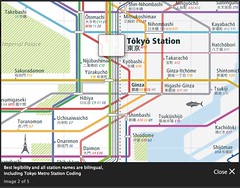 Vollmer Design's superior map of the Tokyo rail and subway system is a must for any visitor to or resident of Tokyo. The map is printed on A3 paper, but is folded small to the size of "3 x 1 2/3 matches" according to the nicely-designed Informa website where the map is available. Very affordable, even inexpensive, at JPY 270 yen online, it's less than the cost of a Starbucks latte, or maybe a typical iPhone app. The map is thankfully bilingual, so a visitor can show it to a Japanese speaker and get help, while reading the romanized versions of the names. It also has clear icon markers of major tourist sites like the Tsukiji Fish Market near Ginza, and the Tokyo Tower.
Vollmer Design's superior map of the Tokyo rail and subway system is a must for any visitor to or resident of Tokyo. The map is printed on A3 paper, but is folded small to the size of "3 x 1 2/3 matches" according to the nicely-designed Informa website where the map is available. Very affordable, even inexpensive, at JPY 270 yen online, it's less than the cost of a Starbucks latte, or maybe a typical iPhone app. The map is thankfully bilingual, so a visitor can show it to a Japanese speaker and get help, while reading the romanized versions of the names. It also has clear icon markers of major tourist sites like the Tsukiji Fish Market near Ginza, and the Tokyo Tower.
Vollmer Design was founded by Ansgar Vollmer and Yoshiko Tajima. The Informa site looks to be Vollmer Design's site specifically for this map. Here's what the Informa site tells us about the map's concept:
The R&S Map provides quick access to this complex city, and is of particular use to short-term visitors. Conventional route maps function only as route-finders and have been made obsolete by today’s digital information systems. The R&S Map, on the other hand, serves as an orientation guide and gives a good conceptual view of the city.Tokyo’s train stations, rather than it is streets, are the important feature of the city. For this reason, because the R&S Map shows all lines and stations as well as geographic information, such as parks, islands, etc. in relative position to each other, it is possible to get the idea of a schematized city map.
I always like to have a map of the complex Tokyo subway system on my wall for easy reference, even though I have lived in Tokyo and Greater Tokyo since 1987. This one's a keeper, and I think even Professor Edward Tufte would be proud [1]. I am looking forward to a map of Yokohama, too, Vollmer Design!
You can buy one here.
Updates
21 May 2009 - Just got mine in the mail from Vollmer Design. It's a small and attractive map!
[1]Tufte is well-known as a, if not the, authority on information design. Check out his incredible books.
Saturday, May 16, 2009
How to Gargle (Ugai Garagara)
Now, this is serious. Today on "Mezamashi Terebi," a popular morning TV show, they had a fairly long, scientific-sounding introduction to "ugai" or gargling. They stated that it's only really popular here in Japan, where all kids are taught "ugai-tearai," or gargling and hand-washing, from when they are toddlers. They had mini-interviews with a bunch of foreigners asking if they had the culture of gargling. Mostly, they didn't, or they did heathen things like drinking the gargle medicine! The horror!
I know where I grew up in the US, it was only recommended when we had sore throats and not really for every day, but here in Japan, it's been incessant, and it is truly part of the culture. Ugai-tearai shita? comes the regular inquiry. Did you gargle-and-wash-your-hands (you filthy mutt, implied)?
But, what don't you know about ugai-tearai? Mezamashi TV (and my mother the nurse) to the rescue:
- Use accepted brands like Isojin if you can, but saltwater or even green tea works too.
- Do a swish-swish through your teeth with the gargle first, and spit it out.
- Sing while gargling, to open up the throat and change its shape, thereby getting the gargle medicine on as much of your throat as possible. You can try a rendition of "sukiyaki". Ue wo muiiite, aaaaruko-o-ooh...
- Tilt your head from side to side, to let the gargle hit the sides of your throat.
- Don't drink the gargle. Spit, for Pete's sake!
Of course with all the Swine Flu going around, maybe it's time to learn to "ugai garagara". For your reference, "garagara" is the onomatopoeia in Japanese for the sound of gargling. Good gargling.
Friday, May 15, 2009
Salaryman Neo's "Salaryman Calisthenics"
This clip is from the TV comedy Salaryman Neo. It's a skit called "Salaryman Taiso" (Taiso = Calisthenics). It's based on the famous, known-by-every-Japanese NHK "rajio taiso", which started off as a calisthenics show on the radio, to piano music, which all Japanese learn. NHK is the epitome of conservative, so it's quite funny to see Japanese "taking the piss" in this irreverant way.
Sunday, May 10, 2009
RIP Kiyoshiro Imawano
Kiyoshiro Imawano, the hugely-popular lead singer of RC Succession died of lymphatic disease at the age of 59. He'll be dearly missed. One of their hits, "Ameagari no Yozora ni" is representative of his music, and you can hear it on YouTube. I thought I'd translate the lyrics to it. The original Japanese is followed by romanized Japanese, followed by my English approximation. It's full of double-meanings, of course.
Ameagari no Yozora ni 雨あがりの夜空に
Buttobase in heaven, Kiyoshiro. RIP!この雨にやられてエンジンいかれちまった
Kono Ame ni Yararete, Engine ikarechimatta
おいらのポンコツとうとうつぶれちまった
Oira no ponkotsu toutou tuburechimatta
どうしたんだ HEY HEY BABY, バッテリーはびんびんだぜ
Doushitanda Hey Hey Baby, Battery wa binbin daze
いつものようにきめてぶっとばそうぜ
Itumonoyouni kimete buttobasouze
My engine's dead from all this rain
My junker's finally died
What's the matter, hey hey baby, the battery's fine
Lookin' cool like always, let's drive it hard
そりゃあひどい乗り方したこともあった
Sorya hidoi norikata shitakoto mo atta
だけどそんなときにもお前はシッカリ
Dakedo, sonna tokinimo omaewa shikkari
どうしたんだ HEY HEY BABY, 機嫌直してくれよ
Doushitanda Hey Hey Baby, Kigen naoshitekureyo
いつものようにキメてブッ飛ばそうぜ
Itsumonoyouni kimete buttobasouze
I rode you hard sometimes
But even then you toughed it out
What's the matter, hey hey baby, why don't you cheer up?
Lookin' cool like always, let's drive it hard
OH! どうぞ勝手に降ってくれ ぽしゃるまで
Oh! Douzo katteni kudattekure, posharumade
WOO! いつまで続くのか見せてもらうさ
Woo! Itsumade tsuzukunoka misetemorausa
こんな夜にお前に乗れないなんて
Konna yoruni omaeni norenai nante
こんな夜に発車できないなんて
Konna yoruni hassha dekinai nante
Oh! Go ahead, fall apart til' you're a wreck
Woo! I'll see how long I can ride you
I can't believe I can't ride you tonight
I can't believe I can't blast off tonight
こんなこといつまでも永くはつづかない
Konna koto itsumademo nagakuwa tsuzukanai
いいかげん明日のこと考えたほうがいい
Iikagen ashita no koto kangaetahouga ii
どうしたんだ HEY HEY BABY お前までそんなこと言うの?
Doushitanda Hey Hey Baby, Omaemade sonna koto iu no?
いつものようにキメてぶっ飛ばそうぜ
Itumono youni kimete buttobasouze
This sort of thing won't continue too long
You gotta think about tomorrow
What's the matter, hey hey baby, are you gonna say that too?
Lookin' cool like always, let's drive it hard
OH! 雨あがりの夜空に輝く
Oh! Ameagari no yozorani kagayaku
WOO! 雲の切れ間にちりばめたダイヤモンド
Woo! Kumo no kirema ni chiribameta diamond
こんな夜におまえにのれないなんて
Konna yoruni omaeni norenai nante
こんな夜に発車できないなんて
Konna yoruni hassha dekinai nante
Oh! They shine in the night sky after the rain
Woo! The diamonds in the breaks in the clouds
I can't believe I can't ride you tonight
I can't believe I can't blast off tonight
お前についてるラジオ 感度最高
Omae ni tsuiteru radio kando saikou
すぐにいい音させてどこまでも飛んでく
Suguni iioto sasete dokomademo tondeku
Your radio's so sensitive
You make great sounds soon and fly away
どうしたんだ HEY HEY BABY, バッテリーはびんびんだぜ
Doushitanda Hey Hey Baby, Battery wa binbin daze
いつものようにきめてぶっとばそうぜ
Itumonoyouni kimete buttobasouze
What's the matter, hey hey baby, the battery's fine
Lookin' cool like always, let's drive it hard
OH! 雨上がりの夜空に流れる
Oh! Ameagari no yozorani nagareru
WOO! ジンライムのようなお月様
Woo! Gin Lime no youna otsuki sama
こんな夜におまえにのれないなんて
Konna yoruni omaeni norenai nante
こんな夜に発車できないなんて
Konna yoruni hassha dekinai nante
Oh! It drifts in the night sky after the rain
Woo! The moon like a gin lime
I can't believe I can't ride you tonight
I can't believe I can't blast off tonight
こんな夜におまえにのれないなんて
Konna yoruni omaeni norenai nante
こんな夜に発車できないなんて
Konna yoruni hassha dekinai nante
I can't believe I can't ride you tonight
I can't believe I can't blast off tonight
Friday, May 1, 2009
English Bookstores in Japan
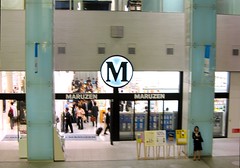 Here are some English bookstores in Japan, but mostly in Tokyo or Yokohama where I live, for the visitor or resident:
Here are some English bookstores in Japan, but mostly in Tokyo or Yokohama where I live, for the visitor or resident:
Maruzen in the Oazo complex (pictured) in front of JR Tokyo station on the Marunouchi side.
1-6-4 Marunouchi, Chiyoda-ku, Tokyo
Tel - 03-5218-5100
Yaesu Book Center on the Yaesu side of JR Tokyo station.
2-5-1 Yaesu, Chuo-ku, Tokyo 104-8456
Tel - 03-3281-1811
Kinokuniya Shinjuku South Store in Takashimaya Times Square, on "Southern Terrace" of JR Shinjuku station's New South Exit.
5-24-2 Sendagaya, Shibuya-ku, Tokyo 151-0051
Tel - 03-5361-3301
Kinokuniya Shinjuku Main Store on the East side of JR Shinjuku.
3-17-7 Shinjuku, Shinjuku-ku, Tokyo 163-8636
Tel - 03-3354-0131
Good Day Books near JR Ebisu, has a large collection of used books.
3F Asahi Building, 1-11-2 Ebisu, Shibuya-ku, Tokyo 150-0013
Tel - 03-5421-0957
Email - goodday@gol.com
Yurindo Landmark Plaza near JR Sakuragicho in the Minato Mirai Landmark Tower.
5F Landmark Tower Mall, 2-2-1-2 Minato-Mirai, Nishi-ku, Yokohama-shi, Kanagawa-ken 220-8172
Tel - 045-222-5500
Wednesday, April 29, 2009
Thierry de Baillon's Article on Social Media in Japan
Thierry de Baillon wrote an article about Japan and social media acceptance, which I thought I'd comment on.
I agree that Social Networking Service acceptance, or lack thereof, is not a simple matter of Japanese being "shy". Just go to Shibuya, Harajuku, or Kabukicho to prove otherwise! I think SNS acceptance is driven by the marketing of the SNS, by whether it "feels right" and "fits right" for Japanese people, and by whether other people are using it. I think that's what Thierry is saying anyway, but my perspective is that SNS's like Mixi are Japanese to begin with and not a localized version of an application like Facebook or MySpace.
Take Mixi: it's Japanese to begin with, so there were no strange hurdles to overcome; it's a bespoke system for Japanese by Japanese. I know a lot of localized applications that were not designed with Japanese in mind, from the language used in the user interface, to the UI layout and its functions, to the way the application was marketed.
Twitter's simple, and it's really easy to explain to people, whether they agree that they would like to participate in what Twitter offers. However, other apps that are more complex, would require quite a bit more explanation and "selling." If something needs selling like that, the sales process in itself is a barrier to adoption, not to mention other barriers like poor Japanese documentation, search that does not work in Japanese, or functional concepts that don't fit Japanese cultural concepts like "amae" which Thierry mentioned.
If you look at who first pushed Twitter here - Digital Garage - it says a lot. One thing that the Japanese joke about often is, their propensity to do things that either thought leaders or, "everyone else" is doing. The Japanese saying that describes this is:
Akashingo wo minna de watareba, kowakunai!
If everyone crosses at the red light, there's nothing to fear!
If Japanese discover something that "everyone else" is doing, many will do it just to see what it's like, whether it makes sense or not. If on the other hand they hear something is "strange" or "a pain" they'll be reluctant to even try. Anyway, that's my two yen on SNS adoption.
Sunday, April 19, 2009
Kakaki Italian in Kugenuma Kaigan near Enoshima
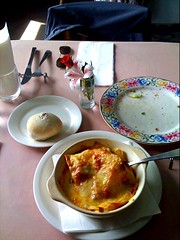 During my 56 km bike ride today, I ate at this nice little Italian place called "Kakaki" in Kugenuma Kaigan near Enoshima, at Kugenuma-bashi, along Rt. 134 the coast road.
During my 56 km bike ride today, I ate at this nice little Italian place called "Kakaki" in Kugenuma Kaigan near Enoshima, at Kugenuma-bashi, along Rt. 134 the coast road.
Address: Kugenuma Kaigan 2-17-21, Fujisawa
Tel: 0466-34-4483
Hours: 11:30 AM-14:30 PM, 17:30 PM-21:00 PM, Closed Mondays
Nearest Station: Kugenuma Kaigan (5 min walk from there)
Parking: 4 spaces
The owner, presumably Mr. Kakaki (?), was personable and spoke English. The table help was a charming young lady, who did a great job despite it probably being her first job, judging from her youth.
The lunch set was about 1500 yen, and included a simple but good vinaigrette salad, "kakaki style" with a little cheese, salami and prosciutto, fresh-baked bread flavored with poppy seed, a choice of pasta and a small dessert. I had the lasagna, which had nice crispy parts and those great-tasting burnt-cheese bits along the edge of the crockery. Yum, I'll be back!
Saturday, April 11, 2009
Yamate Brass 21st Annual - 2009 - ABBA Medley
Daughter unit 1's school did their 21st annual concert at the Kamakura Center for the Performing Arts in early April. This is an Abba medley, probably because of the popularity of Mamma Mia in Japan this year.
Thursday, March 26, 2009
Conti et Mer - Great Tokyo Sandwiches
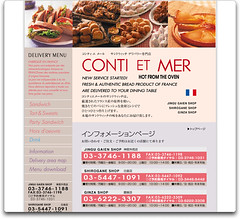
If you're longing for some great sandwiches in Tokyo, try Conti et Mer, who have a good range of "French-style", take-out sandwich boxes and sweets, and party platters. Conti et Mer has three shops, in Jingu-gaien, Shirokane and Ginza, covering most of Tokyo for delivery. Their minimum order is JPY 2000 within their delivery areas, and more for areas outside that.
Sandwiches include Ham and Gruyere Cheese, Foie Gras and Prosciutto, Milano Salami and Cheese, Turkey, Grilled Herb Chicken, Mozzarella and Tomato, Baked Ham and Egg, Ham and Brie Cheese, Pate de Campagne, Prosciutte and Mozzarella, Tuna and Herb Salad, Beef Pastrami, Brie and Vegetable, Terrine Provancale, and Grilled Vegetable.
A "Sandwich Box" set with baguette sandwich, hashed potatoes and a sweet (usually apple pie) costs about JPY 1000 to 1500, or you can get your sandwich in the "Seigle Box" which has the sandwich on rye bread.
These sandwiches might not be exactly authentic French, but they taste great to me. Hope you enjoy them sometime.
Wednesday, March 18, 2009
"Brasserie Bec" in Yoyogi Uehara
 If you like French food but would like it at a more reasonable price than usual in Tokyo, give Brasserie Bec in Yoyogi-Uehara near Shinjuku, Tokyo a try. A project colleague and I went there last night (a Tuesday), and had an excellent meal, with a good French red. Brasserie Bec's impossible to miss, being right in front of the north exit of Yoyogi Uehara station on the Odakyu line, running from points north and south, and the Chiyoda subway line. We were walking from Yoyogi Hachiman, got a little lost, and the cook came out to the street to help us find it after I called in my SOS!
If you like French food but would like it at a more reasonable price than usual in Tokyo, give Brasserie Bec in Yoyogi-Uehara near Shinjuku, Tokyo a try. A project colleague and I went there last night (a Tuesday), and had an excellent meal, with a good French red. Brasserie Bec's impossible to miss, being right in front of the north exit of Yoyogi Uehara station on the Odakyu line, running from points north and south, and the Chiyoda subway line. We were walking from Yoyogi Hachiman, got a little lost, and the cook came out to the street to help us find it after I called in my SOS!
The atmosphere of Brasserie Bec is "relaxed French" I would say. It was late, around 10pm, when we got there, but we got ourselves started with a 5000 yen French red wine from their selection of 80 reds (wide-ranging; go see for yourself!), which seems pretty extensive for a small-ish place like this. The prices of wines were quite reasonable and ranging from 3000-ish to 10000-ish, if I remember correctly.
We each ordered the 4500 yen "four plate course" from the Japanese and French menu. First came a fresh bread basket, with liver pate. It was fabulous. Then, our entrees (appetizers for the Americans in the room) were salad Nicoise and ratatouille, both warm, aromatic and wonderful. A tasty potato soup followed, and after that were our main courses grilled lamb and grilled pork, each with generous portions of vegetables. My lamb was on cous-cous, which combined with the lamb's natural jus to make a nice background to the dish. These mains were both outstanding, we thought; grilled just right. Dessert was a choice between many, but I had gateau chocolat, my friend the marinated strawberries with sherbet.
When we finished it was after midnight, we were the last guests to leave, and we left really satisfied. Brasserie Bec is not pretentious at all, but hearty, good food in a relaxed atmosphere. Reservations: 03-3468-8773.
Friday, March 13, 2009
Bribe Desserts are Just Sour
Since the Lockheed scandal brought Kakuei Tanaka down in the late 1970's, Japan has seen many and varied incidents, their occurrence only escalating in recent years. Even the Tanaka protege Ichiro Ozawa, who has been stressing a (rather two-faced) populist agenda of late, is now tainted by a bribe scandal via a top aide accused of taking corporate donations. Ozawa san, so much for that "for the people" agenda eh? Who's going to replace Aso?!
I like talking to just about anyone, and it's frequently the case that I find myself talking to a random taxi driver about something or other happening in Japan. The other day, during a conversation variously about Ozawa, bribes, the US Sarbanes Oxley legislation and "settai" (client entertainment) in Japan, my "over 60" year old driver told me he worked at Mizkan, the vinegar maker, for 40 years. I assume was his whole career, and he said he was in sales, in charge of large corporate accounts.
He said he invited the big supermarket chain buyers out nightly, for expensive dinners and visits to "caberet clubs" (kyaba-kura) in the Ginza or Kabukicho in Shinjuku. He mentioned, bragging a little, that it was common to spend "a few thousand dollars each night", wining and dining these buyers to ensure getting their business. He made the point though, that most of the companies that were allowing sales reps to entertain them were now bankrupt - Daiei, Seiyu and others. He said they tried wooing the Ito-Yokado buyers, but they were adamant, and never went out. Since 7-and-holding's Ito-Yokado stores are very strong performers today, I think perhaps that company policy of not accepting any sort of bribe was a good one.
My retired ex-Vinegar Maker sales rep and taxi driver must have a sour aftertaste in his mouth, despite all that expensive settai. Just desserts?
Monday, March 9, 2009
Japan Virgin Adventures
A conversation the other day prompted me to recount some experiences of my first days in Japan, so I thought I would share.
What? No NEX?
When I was "fresh off the boat" at Narita way back in 1987, I gathered up my suitcases, met one of the daughters of my host family, and schlepped my too-heavy stuff onto the JR Yokosuka line, which was already full. Japan Rail had no Narita Express yet, so it was stop-by-stop the whole long trip to Zushi, an hour south of Tokyo. Unfortunately we hit rush hour at Tokyo station, so there was another sweaty, smelly hour on an absolutely packed train. Sardines! With two large suitcases. And a backpack. And a total lack of experience on trains at all. This made for a bumpy, crowded, jolting, lurching ride, and kind of sowed my hate for rush hour trains, I think!
When I finally got to Zushi, it was early evening, and we were met at the station by my host parents. I was grateful just to be released from the train, but I almost did not get off, with weak Japanese for saying something like "I'm getting off. Make way!" and way too much stuff. We hauled everything up to my host family's palatial house, and got me situated in a beautiful room overlooking their garden. I thought I would put up with anything to live in this beautiful room.
Gamblin' Vending Machines
Later in the evening, wired from the trip, I took a walk with the host family's daughters, and some friends. I saw a vending maching with a lot of blinking lights, which my cohorts told me were like a slot machine. You put the money in, they start blinking and moving around quickly, and if you can "catch" them when they are in a specific position by pressing the button for your drink, you get a free drink. Well, I won one on the first try, so I got two for the price of one. Surely auspicious, yes? No, just ironic, because I've never won at that since then.
The Ugly American?
One thing I did not want to be was the proverbial "ugly American" so I swore to myself to eat anything that was put in front of me. The first test was at breakfast on the first morning after I arrived. If you've been to middle America, you'll know that it's possible to get some pretty boring food (I'm spoiled now, by Tokyo's cosmopolitan and eclectic food scene). And get it repeatedly. Where I am from, in the suburbs of Pittsburgh, with two hard-working parents, we were eating what I would call typical "meat and potatoes" fare; pretty standard and fairly easy to prepare; by necessity. As I remember, the potatoes and veggies would stay the same, but the meat dish would rotate between burger, pork chops and chicken, usually.
So despite the incantations, I was completely unprepared for this Japanese breakfast. The first morning, I smelled something wafting up to my room that was not exactly appetizing to me. But I repeated my silent pledge. "I'm not going to be the whining, ugly American. I'm going to eat this!" So I trundled myself downstairs, where everyone was awake and busy (busy is pretty typical too, in Japanese houses especially with students around). It was a huge spread of Japanese food. White rice, miso soup, dried seaweed or laver, small smelts (fish) called shishamo, pickled cucumbers, a fried egg. Well, nothing except the egg was familiar, though the rice was easy. I ate everything. I learned that shishamo are meant to be eaten whole, how to wrap some rice in a square of nori, and to have some rice with the pickles because they tend to be pretty salty. Well, I managed to get it all down, despite not feeling so well after the four shishamo fish, heads, fins and all. Grandpa said "calcium!" when he saw my grimacing after the first shishamo assault.
When Grandma asked if I liked the food, I said in my halting Japanese "Hai. Oishii desu!" Afterwards, the daughters were grousing at me, saying "you hated the meal; why did you say you liked it!" I told them my promise not to be the ugly American, but they said "you watch; she'll make it every day now and we'll never see cornflakes again!" Cornflakes!? Anyway, my words must have made Grandma happy because she made that meal, or variations thereof, every morning for the next year, with some exceptions when the whining from the daughters for bread and cornflakes became too much! I came to really love the tastes of Japan, with this experience.
Would you like some Stodgy with that Formal?
One of the primary reasons I came to Japan, was to go to graduate school. Armed with recommendations from my fourth year advisor at Allegheny College, Dr. Wurst, I enlisted my host mother to call the two people I might be able to intern under. The first person was the VP at Chugai Pharmaceuticals. Host mom kindly called this guy up, and he took the next 10 minutes berating her for calling in the first place, and for not having a formal letter of introduction from Dr. Wurst, in the second. She gallantly put up with these hysterics. She told me later about what he said, but I could hear him really hollering at her during the conversation. Strike one of two. So much for that, and I guess a jerk is a jerk in any language.
So, after a little break after calming down from getting screamed at, host mom tried Dr. Sugiyama at Tokyo University. He turned out to be the nicest person, and invited me up for some talk and some evaluation. In the end, he let me in his Masters program, telling me frankly that my Japanese was awful and I'd better do something about it. So this fresh-off-the-boat gaijin committed himself to studying Japanese and Pharmacokinetics hard, and I am really fortunate to have had the chance to study under him. In fact, I think I'm fluent now because of his frank words then.
These experiences gave me some insight into Japan. First, with the case of the VP at Chugai, I've met intensely formal people like that in Japan since that time, and I would say that Japan is probably generally more formal in daily matters as compared to the US. But like the US and like any country, it depends upon the circle you're in, the school, or the company.
Dr. Sugiyama was rather the opposite of the Chugai guy; relatively relaxed and informal. Ironically, while there was a clear hierarchy in Dr. Sugiyama's labs, there was continual confusion over what was the right way, because of the mix between Japanese and other cultures (there were students from Korea and China too). In Japan, and apparently especially in Junior High School, students create and more importantly are allowed (encouraged?) to create hierarchies. Sempai-kohai, senior-junior hierarchies abound, and you don't break them or their influence easily. Sometimes, these things really get out of hand and lead to some serious bullying especially in Junior Highschools. When a Doctoral student, let me call him "Koji", befriended me and insisted that I speak English to him, "Let's speak in English; call me Koji", I was continually corrected by the other students. "No, he is Tanaka Sensei to you." So, I learned to call him Koji, quietly, when speaking English but to call him Tanaka sensei any time else and especially in front of the manners police. I have to say, I'm not a very formal person myself, and so was always kind of bemused by this insistence to go against the guy's wishes by his kohai.
Only after a few drinks, ok?
It's said that the Japanese are inhibited and "shy". Well I'll tell you: not after some drinks, they aren't. I've had several interesting experiences here, but I'll relay three that happened to me when I was in my 20s, early in my stay in Japan, and one later one. The first was when I was wandering in Asakusa. I went to see the famous Kaminarimon, and was walking around the area when this old and drunk guy approached me. He haltingly introduced himself, and immediately started running his hands through my then-long hair. This was when I had a lot of hair. While I squirmed, trying to get away in the crowd, I left this guy saying "so nice" and "so soft". Shudder.
The second interaction was a few years later, on the train in the heat of summer. A really, really drunk guy named Kimura, told me that he and his buddies were firemen, and wanted to make sure I understood Japanese culture. Kimura san slurred "Ith Japanese culchaa, bunka, you see, to givea GIFT to VIZtaa." He thrust out his fan, and would not hear of my trying to give it back. I still have it today. It has "Kimura, 1st Fire Brigade" handwritten in Kanji on its spine. He probably wonders where the heck it went.
The third run-in with Japanese drunk culture was with a guy who took it upon himself to give me money. Said he: "You must be having a hard time. Japan is hard. You take this money." I kept trying to explain to him that I have a full time job, and am doing ok, but I appreciate the gesture. Again, he would not hear of it and stuck a 10,000 yen note in my shirt pocket on the way out the door. But he was drunk, and I knew his wife would be pissed finding out he'd spent some of the family fortune on a random gaijin, so I stuffed the money in his departing back pocket.
Yakuza Ramen Noodle Projectile
I'll leave you with this recent story. A friend and I were working together on a project, and he was here visiting from the UK. We went to a couple of bars after visiting a potential distribution center, and after we were sufficiently sauced, we decided to get one for the road at the train station. Standing right there in front of the kiosk was this older guy dressed in a gaudy white kimono. He had "Yakuza" written all over his face, but we said Shitsurei and went to grab a couple of beers from the kiosk fridge.
Just as I'm trying to pay, and praying for no interactions from him, Mr. White says "what are you drinking..." in slurred English that I could understand being used to the accents here, so I answered him in Japanese. He complimented my language skills, and then insisted on buying our drinks and snacks. The typical refusal-insistence-refusal-insistence dance ensued, and we ended up accepting his hospitality.
That was nice of him and all, but in the middle of our brief conversation he coughed, and a piece of ramen came out of his mouth, and proceeded slow-motion (at least it felt that way to me), to spin end-on-end toward my friend's chest, where it landed with a splat after a few revolutions in mid-air. Our Mr. White was oblivious, but we sort of wiped it off, and got the heck out of there with our Chuhai's and snacks.
A nice introduction to Japanese culture for my friend, wouldn't you say?
Tuesday, March 3, 2009
Doki-doki Camp's "Jack Bauer, Driving Instructor"
If you are a Jack Bauer or 24 fan, you might be surprised to know how popular Jack Bauer is in Japan. Kiefer Sutherland appears in TV commercials for an energy bar called Calorie Mate, and the manzai comedy group in this video, "Doki-doki Camp" (ドキドキキャンプ) does him in various scenes in ordinary Japanese life. In this one, Jack is an instructor at driving school and tells the learner "you're gonna get your license in 24 hours!", and in others, he interviews for a job, pointing a gun at the interviewer while insisting that he'll be the CEO "in 24 hours!". No deaths in the skits, which is somewhat anti-Jack, but it's very funny stuff.
Saturday, February 28, 2009
iPhone in Japan - I am Satisfied
Despite sensationalist, hit-whoring and inane articles like this embarrassing one in Wired [1], as a long-term resident of Japan and Japanese cell-phone user, I think my iPhone is great in many ways. Unless you try to compare it feature-by-feature to Japanese cell phones, that is, but the iPhone is a paradigm shift, typical of many we see from Apple. It's just not the same sort of device, and should not really be compared to Japanese cellphones.
Japanese cell phones are indeed "cutting edge", sure, but a lot of the stuff on them is gimmicky and used infrequently if at all. I hear mention of "WanSeg" TV, but talk about an unpleasant user experience. Watching TV was so confusing on my KDDI AU phone, that I gave up, even after reading the thick manual (yes, I read Japanese). Apple spends great gobs of time and money to make sure their Apps are not like that, though. Apple products are of course not without their problems, but, they're pretty easy to use. That's a huge accomplishment that the feature-hoarders making Japanese cell phones have not understood. Are you listening, Panasonic, Kyocera, NEC, Sharp?
People complain that the iPhone software and hardware is proprietary, but you gotta be kidding me. Japanese cell phones are all about proprietary, in my opinion, and here's a sample of my gripes over the years:
- Different interface per maker. Kyocera is different from Sony is different from Sharp.
- New software to sync with Outlook every time you buy a new phone and limited options to sync with Apple OS X Address Book. Different data format per phone, which makes migrations hard.
- Special formats required for built-in music players, especially Sony. What a chore to get mp3's onto a Sony for playback!
- Number portability was not an option until fairly recently. Now, at least you can keep your number from company to company, for a monthly fee.
- Limited standards adoption, for example in that only a proprietary bluetooth headset can be used with the device.
- Incredibly poor English language text entry handling. My last AU phone from Sony could not enter a space in certain modes and a carriage return in others!
- Limited ability to switch interface into English. Sony allows this, but my Sharp from a year before did not, for instance.
Apple's user interfaces are truly high quality compared to those of Japanese cellphones, but there are indeed a number of aspects about the iPhone which would pose a barrier to adoption, especially for a person very used to the Japanese cellphone ways or modes. No infrared data or personal information exchange, none of the Japan-only stuff like Suica (train pass) or "wallet" function (auto-debit credit card), no hook for a strap, and a different text entry method are some of the things that feel like obstacles.
Regarding these, though, I can exchange data by email or VCard without trouble from my Mac due to the built-in sync to my Mac apps, or, by using an app to do it, I don't want my wallet on my phone because I feel it's a risk so I have never enabled that, I have a case with a strap hook, and the text entry is wildly better, from my perspective, than that on cellphones. Even the TV thing, you can get a frankly unattractive and sort of knobby adapter to hook onto your iPhone to enable WanSeg. Oh, and the expense, well, you're indeed paying a premium, but it's still less than BlackBerry. The device is rather expensive but the data plan monthly is typical for "all you can use" programs here in Japan, running about 45 dollars per month.
On the iPhone upside, well, I mentioned the stellar interface which is multi-lingual. Japanese smartphones feel cheap in your hands comparably. There are some pretty usable apps (app store problems with regard to developer submissions aside) for it for a reasonable price and for apps that you just won't get for a Japanese cellphone. Music-wise, it's the same iPod flexibility we have enjoyed for years on iPod. Very easy to ingest a CD I own into the iTunes library and get it to play. Safari mobile is smooth. Switching between 3G and WiFi is pretty easy and smooth. We also get syncing I never had with a Japanese cell - for mail, calendar, contacts.
From a western perspective, and after 21 years here, I have the opinion that Japanese are not so good at synthesis but much better at analysis. They are quite content to grouse about the state of something (the analysis bit) rather than figuring out how to fix it (the synthesis bit) and without simply copying. If a thought leader explains why a thing is great, though, the Japanese are pretty willing to make that jump. Since Softbank, the only iPhone carrier, is seemingly always being announced as "nearly bankrupt" I am more concerned about Softbank going belly-up than I am about Japanese peoples' ability to figure out why the iPhone is a great device to own.
[1] In response to which there were a large number of comments, some even worth reading, and blog posts here by Mr. Daiji Hirata and here by Mr. Nobuyuki Hayashi. If all Wired's stuff is this poorly done, remind me never to believe anything they have on their site again.
Niigata's Dubious Claim to "Fame" - The Shortest Skirts
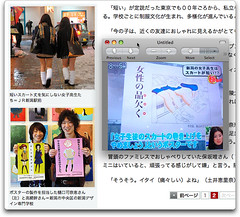 Here's a screenshot of a couple images of the posters being used in Niigata prefecture's crusade to try to prevent girls' skirts from getting any shorter. That Niigata has the girls with the shortest skirts is a dubious claim to "fame" unless you're a lecher or a horny male high-school student.
Here's a screenshot of a couple images of the posters being used in Niigata prefecture's crusade to try to prevent girls' skirts from getting any shorter. That Niigata has the girls with the shortest skirts is a dubious claim to "fame" unless you're a lecher or a horny male high-school student.
On the upper left in the screenshot, the "evidence" - a couple of female students from behind. These skirts are not even so short. Some are just over-the-top short. I can hear Bill Cosby:
Put your brains back in your head! Don't you let your brains fall out of your head! Have you lost your mind?
On the lower left, the designers of the posters hold their creations, and the pink poster says "if you set your mind to it, you can stretch your studies and your skirt". This makes sense in the original language, as "stretch" in this case means improve. The TV capture on the right is a pun on good taste or "grace", meaning girls whose skirts are too short lack it.
Good luck Niigata. I have a teenage daughter, so I know what it is to try to get her to let that hem out!
Friday, February 27, 2009
Free Wifi from freespot.com
FreeSpot.com offers free WiFi in Japan, and here's a map of their WiFi access points. I can't vouch for the quality of this service, but I thought it might be worth a try for visitors to Japan who need WiFi. There are WiFi services via ISPs, but you need an account, which is not practical for a short visit. If you try it, please let me know how it worked, or not, in the comments.
Wednesday, February 25, 2009
JR Stations in Tokyo Soon Smoke-Free
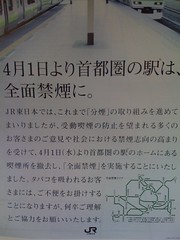 Good news for non-smokers in Tokyo. JR Stations are to be Smoke-free Zones as of April 1st 2009. This poster on the platform at Shinjuku station says:
Good news for non-smokers in Tokyo. JR Stations are to be Smoke-free Zones as of April 1st 2009. This poster on the platform at Shinjuku station says:
And I look forward to breathing fresher air on the platforms.All Stations in Tokyo will be Completely Smoke Free from 1st April
JR East has always had separate zones for smoking and non-smoking, but due to many customers requesting protection from second-hand smoke, and increased drives at companies to discourage smoking, from 1st April the smoking areas on platforms in Tokyo will be removed, and we will begin to implement a "Total No-Smoking" policy. This will be inconvenient for customers who smoke, but we wish to sincerely ask for your understanding and cooperation in this matter.
Yuuri Waterless Urinal Helps Reduce Global Warming
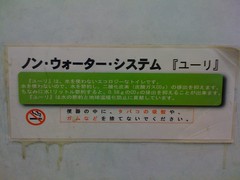 Some places in Japan are very much concerned with the environment. I know we sure do a lot of trash separation, but I had to snap a picture of the sign above a special "ecological" urinal today. I am sure I got a few looks for that!
Some places in Japan are very much concerned with the environment. I know we sure do a lot of trash separation, but I had to snap a picture of the sign above a special "ecological" urinal today. I am sure I got a few looks for that!
The "Yuuri" urinal sign says:
Non-Water System "Yuuri"
Yuuri is an ecological toilet that does not use water. Because it does not use water, water is conserved **, and CO2 gas emissions can be reduced. By the way, for every 1 liter saved, 0.58 grams of CO2 emission can be reduced. Yuuri is effective for both water conservation and reducing global warming.
No smoking. Do not put cigarette butts or gum etc in the urinal.
** Note: Japanese write fairly redundantly like this literal translation, restating things so they can be absolutely sure people understand.
Al Gore would be proud.
Saturday, February 14, 2009
Novartis Zaditen Allergy Medicine Available in Japan
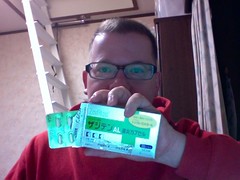 "Zaditen", an allergy medicine from Novartis, is now available over-the-counter in Japan. Last year it was by prescription only, but I'm blogging about it because it works for me where little else did. It's about 1800 yen for a 20 capsule pack, which seems expensive but "welcome to Japan" eh? Its main ingredient seems to be Ketotifen, and I noticed it makes me a little sleepy, but at least I am not wheezing from the Cedar pollen flying down from the mountainous areas of Japan in great clouds. Zaditen might be useful to allergy sufferers in Japan, and you can print this and take it to your local pharmacy (yakkyoku 薬局) to get some, but of course use it at your own risk.
"Zaditen", an allergy medicine from Novartis, is now available over-the-counter in Japan. Last year it was by prescription only, but I'm blogging about it because it works for me where little else did. It's about 1800 yen for a 20 capsule pack, which seems expensive but "welcome to Japan" eh? Its main ingredient seems to be Ketotifen, and I noticed it makes me a little sleepy, but at least I am not wheezing from the Cedar pollen flying down from the mountainous areas of Japan in great clouds. Zaditen might be useful to allergy sufferers in Japan, and you can print this and take it to your local pharmacy (yakkyoku 薬局) to get some, but of course use it at your own risk.
Friday, February 13, 2009
Rick's New Zoff Glasses
Tuesday, February 10, 2009
The Carpenters are Popular in Japan
Every morning on Japanese TV lately, there's a commercial segment that plays a cover of "Top of the World" by The Carpenters. I knew that The Carpenters were popular here, having seen their songs on many a karaoke menu and heard them played pretty consistently. I had mentioned their popularity in Japan to an American friend, who was baffled by it, and I laughingly mentioned this to my wife this AM.
She told me that their songs have been played for years in our local Gumisawa Elementary and in other Elementary Schools around Japan. "Top of the World" starts the day, and "Yesterday Once More" ends it, even on "Rainy Days and Mondays" and on "Saturday"s too. I've never heard such a thing in "All of My Life"! Maybe that is why so many Japanese people like them or feel nostalgic singing their songs at karaoke. Another factor might be that the English in the songs is sung clearly, and so it might be easier to understand for a non-native speaker.
My wife said it changes generation to generation, and her Dad's tune for leaving school was Humoresque (Dvorak). I prefer the Dvorak but that's just me.
"Goodbye and I Love You". [Sorry, couldn't resist. :-) ]
Saturday, February 7, 2009
Eiken 3rd Level Pass
 My daughter Kylie passed the first half of her 3rd level English-as-a-second-language test, the "Eiken" from Step. The numbering system is typically Japanese, where the testees start on the basic level 5, and proceed up to level 1 with a few sub-levels in between. She now has to pass the interview portion to get the certificate, so we plan to practice with her.
My daughter Kylie passed the first half of her 3rd level English-as-a-second-language test, the "Eiken" from Step. The numbering system is typically Japanese, where the testees start on the basic level 5, and proceed up to level 1 with a few sub-levels in between. She now has to pass the interview portion to get the certificate, so we plan to practice with her.
























